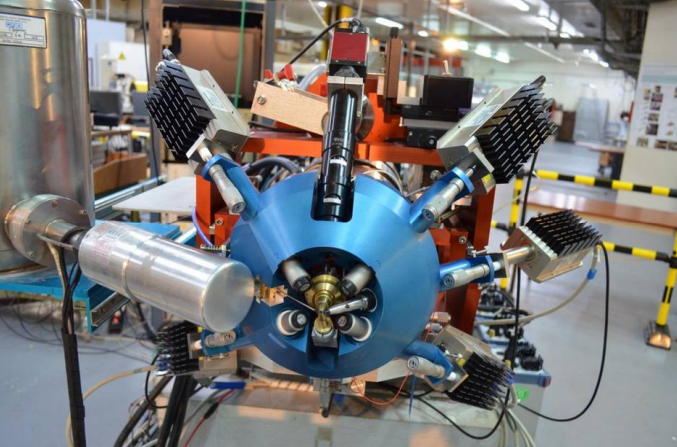 Louvre accelerator gets an upgrade
Louvre accelerator gets an upgrade
by Jennifer Toes (CERN)

New AGLAE multi-detector with 5 SDD PIXE detectors,1 HPGe PIGE detector, optical fiber for IBIL. The annular PIPS E/RBS detector is located inside the beamline, around the beam. (Image: © C2RMF – AGLAE V. Fournier)
Whilst the Parisian Louvre museum may be known as home to some of the world’s most revered and priceless art and antiquities, in the field of high energy physics it is in close proximity to one of premiere sites of the use of accelerators for culture heritage.
The Accélérateur Grand Louvre d'Analyse Elémentaire (AGLAE) is part of the French Ministry of Culture’s Centre for Research and Restoration of Museums of France (C2RMF). The accelerator serves more than 1200 French museums and assists in multiple national and international research projects.
Researchers at C2RMF are able to study objects using ion beam, proton induced X-ray emission (PIXE), proton induced gamma-ray emission (PIGE) and Rutherford Backscattering Spectrometry (RBS) analyses and ion beam induced luminescence (IBIL).
AGLAE’s unique position allows its beamtime to be entirely dedicated to cultural heritage work and can be used to answer questions on the provenance, composition, authentication and degradation of objects made of stone, metals, glass, and ceramics.
In effort to increase the capability of the AGLAE facilities, an upgrade of the accelerator is ongoing. The “New AGLAE” will include a multi-detector system and will allow for systematic imaging and the automation of the beamline.
New particle analysis techniques will minimise the risk of damage to test subject – a crucial concern in cultural heritage studies.
“The New AGLAE project is part of the development, upgrading and optimization of the beamline since its settlement in the Louvre premises in 1988 for its specific applications to art objects with their proper constraints,” says Claire Pacheco, leader of the AGLAE research group.
Five silicon drift detectors (SDDs) have replaced the former two Si(Li), which will provide bigger solid angles, enabling the study of more fragile materials.
The area of interest on the object is scanned combining a vertical magnetic deflection of the beam up to 500µm and a horizontal mechanical translation of the target. The ListMode acquisition, coupled with the scanning of the area previously described, enables systematic chemical imaging.
Increasing the hours of beamtime is crucial to meeting the growing domain of work completed with the AGLAE. A more constant, automated beamline would not only allow further study of the museum collection, but would also provide access to the increasing number of project proposals submitted to the C2RMF.
As such, a call for bids to upgrade the beamline was opened in 2014 and later awarded to Thales.
The Thales proposal aims to provide control of the Terminal Voltage via a digital system which is to be integrated directly into the industrial automated machine. In addition, the alpha zone will house two 90° and two 45° magnets, and a quadrupole triplet enabling the beam to be more stable in energy and position. Finally, a customised human-machine interface (HMI) will be installed for operation and maintenance of the machine.
The installation and testing of the New AGLAE is due to be completed and ready for users by July 2017. A call for proposals is open twice a year and European user groups can be financially supported by the European Commission through the IPERION CH programme.
Commenting on the future of the facility, Claire Pacheco says: “We are looking forward to welcoming the French and European users at the New AGLAE facility and to showing them its new capabilities.”
-
Claire Pacheco presented a seminar organised by the CERN Knowledge Transfer (KT) Department in January 2017.